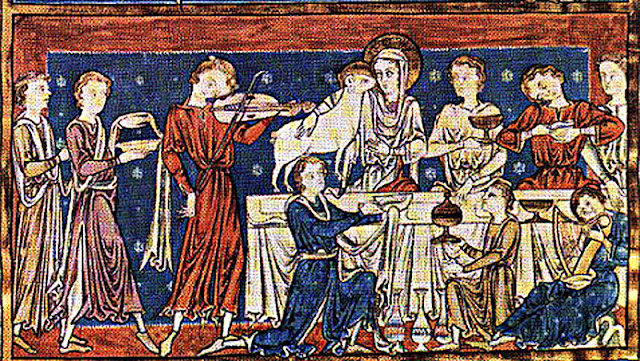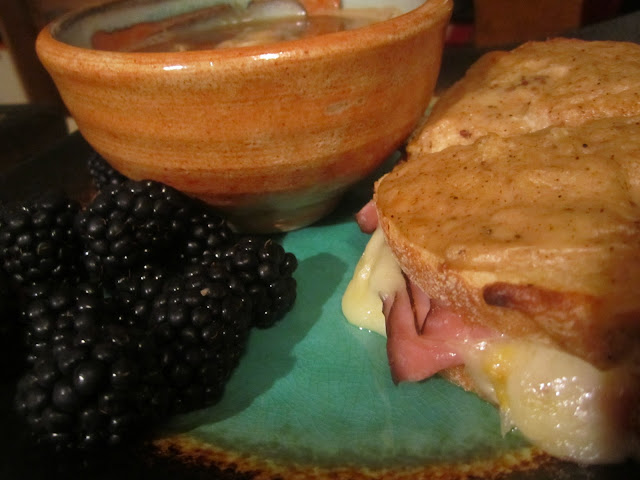Merry Christmas from your local medievalist! Here are some fun ideas to kick your Christmas olde school. The 12 days of Christmas start after December 25th and run through January 6th (The Feast of Epiphany), and in honor of those days I will attempt to fill your holiday with some medieval fun!
So, I thought we could start with a look at medieval food and drink that would have been served during the Christmas season. Also, Christmas feasts allowed for many culinary indulgences (read: really bizarre foods) that were otherwise frowned upon during the liturgical calendar.
And I ask you, who doesn't like learning about food and table customs? I mean, seriously.
On Christmas Eve during the medieval period the fasting observed through Advent would have still been in effect and all dishes comprised of meat, chicken, milk, cheese, and butter were prohibited. Therefore, we can't begin with a menu of full on feastly fares, but here is a list of some of the drinks and dishes that would have appeared on a medieval table during the holiday season. Also, did you know that sections in medieval cookbooks for feast days and appropriate foods for fasting were clearly marked? These sections included a great deal of interesting things to do with fish and assorted seafood, resulting in things like Barnacle Goose(??!!). Fried foods were fried with nut oils rather than animal fat. Oh, and almond milk was used to 'lighten' certain dishes, both sweet and savory, and was used as a substitute for milk.
WASSAIL:
Ever made wassail? It is basically a delicious spiced drink that is very easy to make and is enjoyed by all.
Here is a great recipe, and
learn about the history of wassail here. And in the spirit of wassail and good cheer, don't forget to add "Here We Come a Wassailing" to your Christmas carol queue! I will even get you started...
Here we come a-wassailing
Among the leaves so green;
Here we come a-wand'ring
So fair to be seen.
Love and joy come to you,
And to you your wassail too;
And God bless you and send you a Happy New Year
And God send you a Happy New Year.
CLARREY and POTUS YPOCRAS were two other such mulled wine drinks.
Clarrey can be made by bringing a bottle of white wine and 1-2 cups of honey to a boil, skim off the film as it rises. Remove from heat and add 1tbs each of cinnamon, cardamon, and ground ginger, and 1 tsp of white pepper. Let the mix sit covered for 24 hours. After sitting, strain the wine into another container and bottle. Make the mulled wine up to a month before serving.
Potus Ypocras -Hippocrates' Drink- is very similar to clarrey but with the addition of a few extra spices and can be used to refer to either a red or white wine mixture. To make it bring a bottle of sweet red or white wine and 1-2 cups of sugar to boil, skim off the film as it rises. Remove from heat and stir in 1 tbs each of cinnamon, cardamon, ground ginger, white pepper, clove, nutmeg, and caraway seed. Let the mix sit covered for 24 hours. After sitting, strain the wine into another container and bottle. Make the mulled wine up to a month before serving.
CAUDELL:
And for you brave folks out there, you can brew a cup of caudell - which is a wine thickened with eggs. The modernized version of the recipe is something like this,
5 egg yolks
2/3 cup white wine
sugar to taste
a pinch of saffron
Add all of the ingredients into a pot on the stove over medium heat. Stir the mixture continuously until the caudell is hot, thick, and fluffy. DO NOT LET IT SCALD, STICK TO THE BOTTOM OF THE PAN, OR BURN. It will become super nasty if you let this happen. Serve immediately as a drink or as a sauce over your favorite dessert.
As already mentioned, there were several dietary restrictions for fast days, but medieval cooks were not thwarted by this and did several things to circumvent those restrictions. These included recipes featuring beaver's tail (hey, they lived in the water, right???), and ordinary geese were sold and consumed under the nom de plume Barnacle Goose. A barnacle goose was said to have been a type of goose that "blossomed" from a nautical plant called a barnacle tree, ergo, it was not a "true goose" and could be served on fast days.
Inspired yet? I hope so! Check out these books for more ideas, as they have greatly influenced these posts, and are truly awesome reads.
The Art of Cookery in the Middle Ages by Terrance Scully
Food and Feasts in Medieval England by P. W. Hammond
Fast and Feast: Food in Medieval Society by Bridget Ann Henisch
Also, here is a link to a collection of manuscript folios of medieval 'cury' or 'cookery'. You can see what some of these recipes looked like!

















































